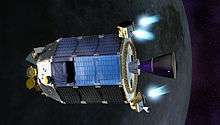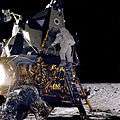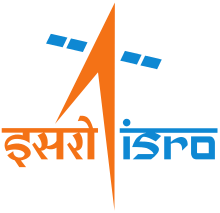Chandrayaan-2
| Mission type | Lunar orbiter, lander, rover | ||||
|---|---|---|---|---|---|
| Operator | Indian Space Research Organisation | ||||
| Mission duration |
Orbiter: 1 year Lander: 14-15 days[1] Rover: 14-15 days[1] | ||||
| Spacecraft properties | |||||
| Manufacturer | ISRO | ||||
| Launch mass | Combined: 3,250 kg (7,170 lb)[2] | ||||
| Payload mass |
Orbiter: 1,400 kg (3,100 lb) Rover: 20 kg (44 lb)[3] | ||||
| Start of mission | |||||
| Launch date | Planned: December 2018 | ||||
| Rocket | GSLV Mk II[4] | ||||
| Launch site | Satish Dhawan | ||||
| Contractor | ISRO | ||||
| Lunar orbiter | |||||
| Orbit parameters | |||||
| Periselene | 100 km (62 mi)[2] | ||||
| Aposelene | 100 km (62 mi)[2] | ||||
| |||||
Chandrayaan-2 (Sanskrit: चन्द्रयान-२; Sanskrit: [ t͡ʃʌnd̪ɾʌːjaːn d̪ʋi]; lit: Moon-vehicle[5][6] ![]() pronunciation ) is India's second lunar exploration mission after Chandrayaan-1. Developed by the Indian Space Research Organisation (ISRO), the mission is planned to be launched to the Moon by a Geosynchronous Satellite Launch Vehicle (GSLV Mk II).[4] It includes a lunar orbiter, lander and rover, all developed by India. India is planning to launch Chandrayaan-2 by 2018.[7]
pronunciation ) is India's second lunar exploration mission after Chandrayaan-1. Developed by the Indian Space Research Organisation (ISRO), the mission is planned to be launched to the Moon by a Geosynchronous Satellite Launch Vehicle (GSLV Mk II).[4] It includes a lunar orbiter, lander and rover, all developed by India. India is planning to launch Chandrayaan-2 by 2018.[7]
According to ISRO, this mission will use and test various new technologies and conduct new experiments.[8][9][10] The wheeled rover will move on the lunar surface and will pick up soil or rock samples for on-site chemical analysis. The data will be relayed to Earth through the Chandrayaan-2 orbiter.[11]
History
On 12 November 2007, representatives of the Russian Federal Space Agency (Roscosmos) and ISRO signed an agreement for the two agencies to work together on the Chandrayaan-2 project.[12] ISRO would have the prime responsibility for the orbiter and rover, while Roscosmos was to provide the lander.
The Indian government approved the mission in a meeting of the Union Cabinet, held on 18 September 2008 and chaired by Prime Minister Manmohan Singh.[13] The design of the spacecraft was completed in August 2009, with scientists of both countries conducting a joint review.[14][15]
Although ISRO finalized the payload for Chandrayaan-2 per schedule,[16] the mission was postponed in January 2013[17] and rescheduled to 2016 because Russia was unable to develop the lander on time.[18][19] Roscosmos later withdrew in wake of the failure of the Fobos-Grunt mission to Mars, the reason being that technical aspects connected with the Fobos-Grunt mission were also used in the lunar projects, which need to be reviewed.[18] When Russia cited its inability to provide the lander even by 2015, India decided to develop the lunar mission independently.[17]
Design
The mission is planned to fly on a Geosynchronous Satellite Launch Vehicle (GSLV Mk II) with an approximate lift-off mass of 3,250 kg (7,170 lb) from Satish Dhawan Space Centre on Sriharikota Island.[2][4][20] As of December 2015, the mission has an allocated cost of ₹603 Crore (US$91 million).[21]
Orbiter
The orbiter will orbit the Moon at an altitude of 100 km (62 mi).[22] The mission would carry five instruments on the orbiter. Three of them are new, while two others are improved versions of those flown on Chandrayaan-1. The approximate launch mass will be 1,400 kg (3,100 lb).[16][20] The Orbiter High Resolution Camera (OHRC) will conduct high-resolution observations of the landing site prior to separation of the lander from the orbiter.[22][1] Interfaces between the orbiter and its GSLV Mk II launch vehicle have been finalised.[23]
Lander
Unlike Chandrayaan-1's Moon Impact Probe, which impacted the Moon's surface, the lander will make a soft landing to then deploy the rover.[20] The lander will not perform any scientific activities. The approximate mass of the lander and rover is 1,250 kg (2,760 lb). Initially, the lander was slated to be developed by Russia in collaboration with India. When Russia stated its inability provide the lander to meet even the revised time frame of 2015, Indian officials decided to develop the lander independently. The cancellation of the Russian lander also meant that mission profile had to be changed. The preliminary configuration study of the indigenous lander was completed in 2013 by the Space Applications Centre (SAC) in Ahmedabad.[17]
The research team identified methods for a soft landing on the lunar surface, as well as the associated technologies that would be needed for such an event. Amongst these technologies are a high resolution camera, navigation camera, hazard avoidance camera, an 800 N (180 lbf) throttleable liquid main engine and attitude thrusters, altimeter, velocity meter, accelerometer, and the software needed to run these components.[1][22] The lander's main engine has successfully undergone a high altitude test for a duration of 513 seconds, and closed loop verification tests of the sensors, actuators and software are planned for the middle of 2016.[23] Engineering models of the lander began undergoing ground and aerial tests in late October 2016, in Challakere in the Chitradurga district. The ISRO created roughly 10 craters in the surface to help assess the ability of the lander's sensors to select a landing site.[24]
| Subsystem | Quantity | Mass (kg) | Power (W) |
|---|---|---|---|
| INS[25] | 1 | 20 | 100 |
| Star tracker[25] | 2 | 6 | 15 |
| Altimeter[25] | 2 | 1.5 | 8 |
| Velocimeter[25] | 2 | 1.5 | 8 |
| Imaging sensor[25] | 2 | 2 | 5 |
Rover
The rover's mass will be about 20 kg (44 lb) and will operate on solar power.[3] The rover will move on wheels on the lunar surface, pick up samples of soil or rocks, perform on-site chemical analysis and send the data to the orbiter above, which will relay it to the Earth station.[16][20]
The initial plan was for the rover to be designed in Russia and fabricated in India. However, Russia gave up in May 2010 on its plan on designing the rover.[17][18][19] Subsequently, ISRO decided on designing and fabricating the rover. IIT Kanpur is developing three subsystems to provide mobility:
- Stereoscopic camera-based 3D vision - will provide the ground team controlling the rovers a 3D view of the surrounding terrain.
- Kinematic traction control - will enable the rover to negotiate the rough lunar terrain using independent steering provided on four of its wheels.
- Control and motor dynamics - The rover will have six wheels, each driven by an independent electric motor. Four of the wheels will also be capable of independent steering. A total of 10 electric motors will be used for traction and steering.
Payload
ISRO has announced that an expert committee has decided on five payloads for the orbiter, and two for the rover.[16][26] While it was initially reported that NASA and ESA would participate in the mission by providing some scientific instruments for the orbiter,[27] ISRO has later clarified that due to weight restrictions it will not be carrying foreign payloads on this mission.[28]
- Orbiter payload
- Large Area Soft X-ray Spectrometer (CLASS) from ISRO Satellite Centre (ISAC), Bangalore and Solar X-ray monitor (XSM) from Physical Research Laboratory (PRL), Ahmedabad for mapping major elements present on the lunar surface.[16]
- L and S band Synthetic Aperture Radar (SAR) from Space Applications Centre (SAC), Ahmedabad for probing the first few tens of metres of the lunar surface for the presence of different constituents, including water ice. SAR is expected to provide further evidence confirming the presence of water ice below the shadowed regions of the Moon.[16]
- Imaging IR Spectrometer (IIRS) from SAC, Ahmedabad for mapping of lunar surface over a wide wavelength range for the study of minerals, water molecules and hydroxyl present.[16]
- Neutral Mass Spectrometer (ChACE-2) from Space Physics Laboratory (SPL), Thiruvananthapuram to carry out a detailed study of the lunar exosphere.[16]
- Terrain Mapping Camera-2 (TMC-2) from SAC, Ahmedabad for preparing a three-dimensional map essential for studying the lunar mineralogy and geology.[16]
- Lander payload
- Seismometer for studying Moon-quakes near the landing site[2][29]
- Thermal probe for estimating the thermal properties of the lunar surface[2]
- Langmuir probe for measuring the density and variation of lunar surface plasma[2]
- Radio occultation experiment for measuring the total electron content[2]
- Rover payload
- Laser induced Breakdown Spectroscope (LIBS) from Laboratory for Electro Optic Systems (LEOS), Bangalore.[16]
- Alpha Particle Induced X-ray Spectroscope (APIXS) from PRL, Ahmedabad.
See also
References
- 1 2 3 4 Nair, Avinash (31 May 2015). "ISRO to deliver "eyes and ears" of Chandrayaan-2 by 2015-end". The Indian Express. Retrieved 7 August 2016.
- 1 2 3 4 5 6 7 8 Kiran Kumar, Aluru Seelin (August 2015). Chandrayaan-2 - India's Second Moon Mission. YouTube.com. Inter-University Centre for Astronomy and Astrophysics. Retrieved 7 August 2016.
- 1 2 Subramanian, T. S. (11 May 2014). "Chandrayaan's rover and the moon rocks from Salem villages". The Hindu. Retrieved 2 October 2014.
- 1 2 3 Shenoy, Jaideep (28 February 2016). "ISRO chief signals India's readiness for Chandrayaan II mission". The Times of India. Times News Network. Retrieved 7 August 2016.
- ↑ "candra". Spoken Sanskrit. Retrieved 5 November 2008.
- ↑ "yaana". Spoken Sanskrit. Retrieved 5 November 2008.
- ↑ Prasad, S. (23 January 2016). "Chandrayaan-2 launch likely by 2018". The Hindu. Retrieved 29 January 2016.
- ↑ Mallikarjun, Y. (7 September 2007). "Chandrayaan-2 to be finalised in 6 months". The Hindu. Retrieved 22 October 2008.
- ↑ "Chandrayaan-II will try out new ideas, technologies". The Week. 7 September 2010. Archived from the original on 14 July 2011. Retrieved 7 September 2010.
- ↑ "Landing spots for Chandrayaan-2 identified". DNA India. 21 February 2014. Retrieved 23 February 2014.
- ↑ Subramanian, T. S. (4 January 2007). "ISRO plans Moon rover". The Hindu. Retrieved 22 October 2008.
- ↑ Chand, Manish (12 November 2007). "India, Russia to expand n-cooperation, defer Kudankulam deal". Nerve. Archived from the original on 13 January 2014. Retrieved 12 January 2014.
- ↑ Sunderarajan, P. (19 September 2008). "Cabinet clears Chandrayaan-2". The Hindu. Retrieved 23 October 2008.
- ↑ "ISRO completes Chandrayaan-2 design". Domain-b.com. 17 August 2009. Retrieved 20 August 2009.
- ↑ "India and Russia complete design of new lunar probe". Sputnik News. RIA Novosti. 17 August 2009. Retrieved 20 August 2009.
- 1 2 3 4 5 6 7 8 9 10 "Payloads for Chandrayaan-2 Mission Finalised" (Press release). Indian Space Research Organisation. 30 August 2010. Retrieved 4 January 2010.
- 1 2 3 4 Ramachandran, R. (22 January 2013). "Chandrayaan-2: India to go it alone". The Hindu.
- 1 2 3 Laxman, Srinivas (6 February 2012). "India's Chandrayaan-2 Moon Mission Likely Delayed After Russian Probe Failure". Asian Scientist. Retrieved 5 April 2012.
- 1 2 "India's next moon mission depends on Russia: ISRO chief". NDTV. Indo-Asian News Service. 9 September 2012.
- 1 2 3 4 "Chandrayaan-2 to get closer to moon". The Economic Times. 2 September 2010. Retrieved 4 January 2011.
- ↑ "Successful commercial launches boost ISRO's reputation in 2015". Business Standard. 29 December 2015. Retrieved 2 April 2016.
- 1 2 3 "Annual Report 2014-2015" (PDF). Indian Space Research Organisation. December 2014. p. 82.
- 1 2 "Annual Report 2015-2016" (PDF). Indian Space Research Organisation. December 2015. p. 89.
- ↑ D. S., Madhumathi (25 October 2016). "ISRO starts landing tests for Chandrayaan-2 mission". The Hindu. Retrieved 28 October 2016.
- ↑ Johnson, T. A. (31 August 2010). "Three new Indian payloads for Chandrayaan 2, decides ISRO". The Indian Express. Retrieved 31 August 2010.
- ↑ Beary, Habib (4 February 2010). "NASA and ESA to partner for Chandrayaan-2". Sakal Times. Retrieved 22 February 2010.
- ↑ Laxman, Srinivas (5 September 2010). "'We're launching Chandrayaan-2 for a total coverage of the moon'". The Times of India.
- ↑ Mallikarjun, Y. (29 May 2013). "India plans to send seismometer to study moonquakes". The Hindu. Retrieved 1 June 2013.
External links
- Chandrayaan-2 at ISRO.gov.in


